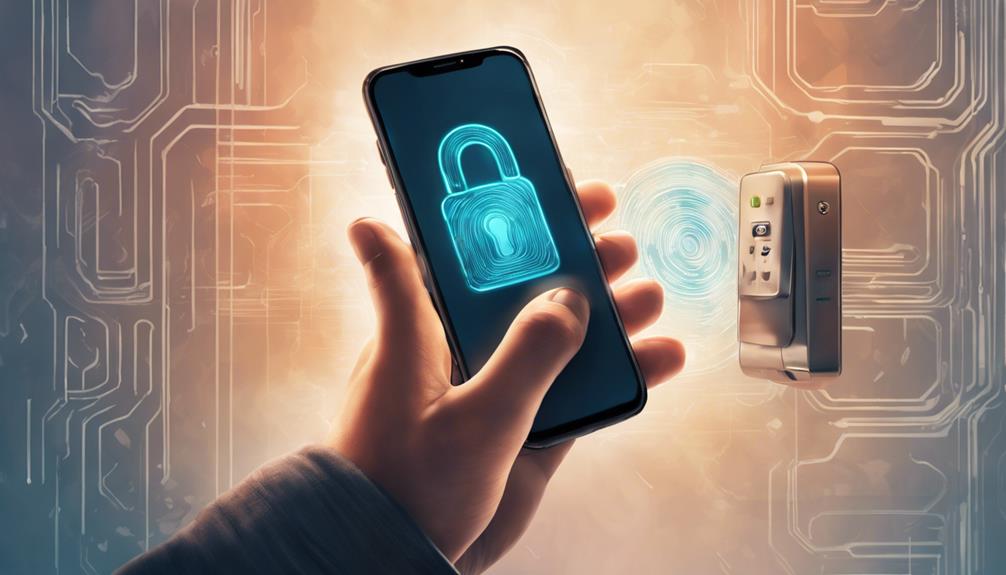To keep your phone safe from hackers, prioritize lock screen security with passcodes or biometric authentication. Regularly update your device software to receive security patches. Download apps only from trusted sources like Google Play Store. Embrace two-factor authentication for robust account security endorsed by major platforms. Install reputable security apps such as Lookout or Norton Mobile Security for added protection. Remember, safeguarding your phone through these practices sets a strong foundation against cyber threats.
Key Takeaways
- Utilize strong lock screen security measures.
- Regularly update software and apps.
- Download apps only from trusted sources.
- Enable two-factor authentication for accounts.
- Install reputable security apps for malware detection.
Lock Screen Security
Establishing a robust lock screen system is essential for safeguarding your phone against unauthorized access by hackers. Secure your phone by using a passcode lock or pattern that is not easily guessable.
Additionally, incorporating biometric authentication methods such as facial recognition or fingerprint scanning adds an extra layer of security to your device. These features help protect your personal data from falling into the wrong hands.
Unauthorized access to your phone can lead to a breach of sensitive information, making it imperative to prioritize lock screen security. Avoid sharing your passcode with others to maintain the confidentiality of your personal data.
By enabling facial recognition, you make certain that only you can access your device, reducing the risk of unauthorized entry.
In the digital age, where cyber threats are prevalent, taking proactive steps to secure your phone through a reliable lock screen system is paramount for safeguarding your personal information.
Software Updates

To strengthen your phone's defense against potential cyber threats, ensuring that you regularly update your device's software is essential. Regular software updates play a pivotal role in maintaining the security of your phone. By installing the latest operating system updates, you can address security vulnerabilities and protect your device from hackers. These updates often include critical patches and enhancements that fortify your phone's security features.
Setting your phone to update automatically is a proactive measure that guarantees you receive the latest security improvements without any delay. Additionally, updating your apps regularly is important for safeguarding your personal data and preventing potential security breaches.
Following the recommended update procedures from your device's manufacturer can greatly contribute to keeping your phone safe from hackers. By staying up to date with software updates, you are actively enhancing the security of your device and minimizing the risk of unauthorized access to your personal information.
Trusted App Downloads

Using reputable app stores such as Google Play Store or Apple App Store is crucial for guaranteeing the security of your phone against potential malware and hacking threats. Official app stores have stringent security measures in place to verify and validate apps before they are offered for download. By utilizing trusted sources for app downloads, you can minimize the risk of falling prey to hacking attempts and safeguard your personal information and data.
To emphasize the importance of downloading apps from official app stores, consider the following comparison table:
| Third-Party App Stores | Official App Stores |
|---|---|
| Host malicious apps | Vet and verify apps |
| Pose security risks | Strict security measures |
| May compromise personal data | Ensure app legitimacy |
| Lack credibility | Prioritize user safety |
Two-Factor Authentication

Two-factor authentication, a critical security measure, offers a robust defense against unauthorized access to your accounts.
By requiring a second form of verification, such as a unique code or biometric data, it greatly enhances the protection of your personal information.
Platforms like Google, Facebook, and Apple advocate for this additional layer of security to safeguard user accounts effectively.
Secure Login Methods
Enhancing the security of your accounts can be achieved through the implementation of two-factor authentication, which requires a second form of verification. This method adds an extra layer of security, reducing the risk of unauthorized access, even if your password is compromised.
Secure login methods such as using an authenticator app or receiving a code via text or email are common practices for two-factor authentication. By enabling this feature on all accounts that support it, users can greatly enhance their protection against hackers.
Diverse Verification Methods: Two-factor authentication offers different ways to verify your identity, such as through codes sent via text, email, or generated by an authenticator app.
Enhanced Security: Implementing two-factor authentication provides an additional barrier that makes it harder for unauthorized individuals to access your accounts.
Mitigating Password Vulnerabilities: Even if your password is compromised, the second form of verification adds an extra level of protection.
Widespread Availability: Many applications and online services now offer two-factor authentication as an optional security feature, making it accessible to a broad range of users.
Verification Code Protection
Implementing a secondary verification code system enhances the security of your accounts by requiring an additional layer of authentication beyond just a password.
Two-factor authentication, commonly known as 2FA, involves the use of a verification code along with your regular login credentials. This code is often sent to your phone via SMS or generated by an authentication app.
By requiring this extra step, two-factor authentication adds an extra layer of security, making it notably harder for hackers to gain unauthorized access to your accounts, even if they somehow obtain your password.
Major online services and apps widely support two-factor authentication as a robust security measure. Setting up two-factor authentication is a proactive step every individual should take to protect their accounts from potential hacking attempts.
App-Specific Authentication
Utilizing app-specific authentication for added security measures in account protection is becoming increasingly important in the digital landscape. Two-factor authentication, a key component of app-specific authentication, adds an extra layer of security by requiring users to verify their identity through a second method.
Many security apps, websites, and services offer two-factor authentication options to safeguard user accounts from unauthorized access attempts. Common methods of two-factor authentication include receiving a code via SMS, using a security key, or employing biometric verification such as fingerprint or facial recognition.
Enabling two-factor authentication can greatly reduce the risk of unauthorized access to your accounts, even if your password is compromised. It is essential to set up two-factor authentication for all your essential accounts to enhance their security against potential hackers.
Security App Installation

When it comes to safeguarding your phone against hacking threats, installing reputable security apps is essential. These apps offer a range of features such as malware detection, anti-theft tools, and data encryption to enhance your device's protection.
Choosing the best security apps and following proper installation tips can greatly bolster your phone's security measures.
Best Security Apps
Consider installing reputable security apps like Lookout, Norton Mobile Security, or Avast Mobile Security to enhance the protection of your phone against hackers. These secure apps offer essential features such as malware detection, anti-phishing protection, and device tracking to guarantee thorough security for your device.
When selecting a security app, it is advisable to look for high ratings and positive reviews in the App Store or Google Play Store, indicating their effectiveness in combating security threats. By utilizing these security apps, you can safeguard your personal data, prevent unauthorized access, and receive timely alerts about potential cyber threats.
Remember to regularly update your chosen security app to stay ahead of evolving security risks and ensure you have the latest protection against potential vulnerabilities.
- Malware Detection: Identify and eliminate malicious software that could compromise your device's security.
- Anti-Phishing Protection: Guard against phishing attempts that aim to steal your sensitive information.
- Device Tracking: Locate your device in case of loss or theft, enhancing security measures.
- Regular Updates: Make sure your security app stays current with the latest defenses against emerging cyber threats.
Installation Tips
To guarantee the effective protection of your phone from hackers, understanding the proper installation process for security apps is essential.
When installing security apps, such as McAfee or Norton, it is important to choose reputable ones with high ratings and positive reviews. These apps play a critical role in detecting and removing malware, blocking malicious websites, and offering anti-theft features to safeguard your device.
To maximize your phone's security, make sure that the security app is regularly updated to defend against new threats and vulnerabilities. When installing the app, follow the installation prompts carefully and grant necessary permissions as requested.
Strong Password Usage

Creating a robust password incorporating a combination of letters, numbers, and special characters is essential to bolstering the security of your accounts. When it comes to protecting your phone and personal information, strong password usage is key.
Here are four vital tips for ensuring the safety of your sensitive data:
- Avoid Common Passwords: Steer clear of predictable passwords like '123456' or 'password' as they pose a significant security issue, making it easier for hackers to access your accounts.
- Regular Password Changes: Changing your passwords frequently adds an extra layer of security, reducing the risk of unauthorized access to your accounts and personal info.
- Utilize Password Managers: Consider using a password manager to securely store passwords for different accounts, ensuring that your login credentials are well-protected.
- Implement Two-Factor Authentication: Enabling two-factor authentication provides an added level of security by requiring both a password and a verification code, enhancing the protection of your sensitive data.
Operating System Updates

When it comes to safeguarding your phone against potential cyber threats, one crucial aspect to prioritize is regularly updating your operating system. Operating system updates provide critical security patches that protect your device from vulnerabilities that hackers might exploit.
Setting your phone to update automatically guarantees that you receive the latest security enhancements promptly.
In addition to operating system updates, keeping your apps up to date is equally important in addressing security vulnerabilities and safeguarding your phone. For Apple users, updating your device can be done through the Settings app, while Android users can check and update their system via the Settings menu.
Antivirus Software Installation

How can you enhance the security of your phone against malware and hacking attempts? Installing reputable antivirus software is essential. Here are four key steps to safeguard your device:
- Install Antivirus Software: Choose a trusted antivirus program to scan for and eliminate malicious software, bolstering your phone's defenses.
- Regularly Update Antivirus Software: Make sure your antivirus software is always up-to-date to shield your phone against evolving security risks.
- Utilize Real-Time Protection: Activate real-time monitoring on your antivirus software to receive instant alerts about potential security threats, safeguarding your sensitive data.
- Detect and Block Suspicious Activities: Leverage the capabilities of antivirus programs to identify and block any suspicious activities on your phone, enhancing overall security measures.
Frequently Asked Questions
Can I Stop My Phone From Being Hacked?
Protecting your phone from hacking requires vigilance. Implement strong passwords, enable two-factor authentication, update your phone regularly, avoid untrusted apps, be cautious of suspicious links, and consider using antivirus software for added security measures.
Can You Check to See if Your Phone Is Hacked?
To determine if your phone has been hacked, look for signs of unusual activity, such as unexpected calls or texts, abnormal battery usage, or performance issues. Utilize security apps to scan for malware and consult cybersecurity experts for assistance.
Can You Tell if Someone Has Access to Your Phone?
In the digital world, detecting unauthorized access to your phone is akin to spotting a thief in a crowded marketplace. Look for telltale signs such as unusual activity, sudden changes in usage patterns, unfamiliar logins, and consider using security apps for added protection.
Can Hackers See Everything You Do on Your Phone?
Hackers can potentially access personal data, messages, photos, and financial information on your phone through various means like malicious apps or phishing attacks. Implementing strong security measures such as two-factor authentication and regular software updates can help prevent unauthorized access.
Conclusion
In conclusion, implementing strong security measures on your phone is vital to protect it from hackers. By following the outlined steps such as using lock screen security, updating software regularly, and installing security apps, you can greatly reduce the risk of unauthorized access to your device.
According to a recent study, 60% of smartphone users have experienced some form of cyber attack, highlighting the importance of taking proactive steps to safeguard your personal information.









